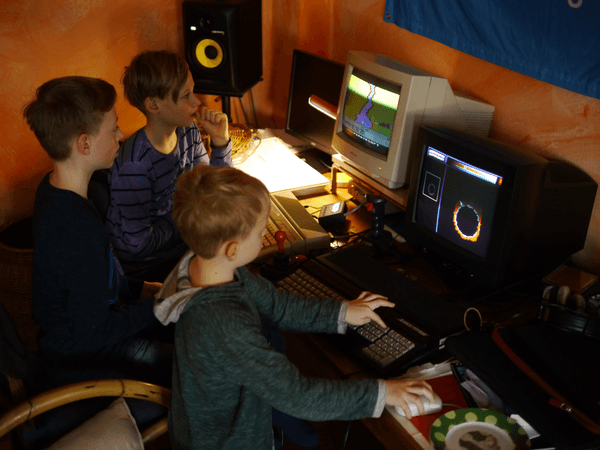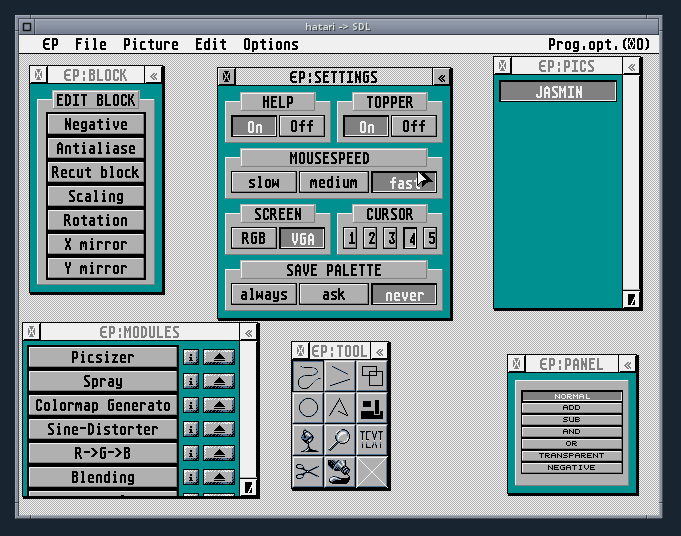Resurrecting Escape Paint with Hatari
A recent series of events flared up my enthusiasm for Atari home computers. I just couldn't help but draft a plan of bridging this nostalgic trip with our modern-day Sculpt OS.
Before Genode was born, I dedicated my life to Atari computers, regarding the wonderful people of the Atari demo scene as my second family. This is how my living room looked like back in the day. My entrance into the demo scene was a paint program called Escape Paint, which I developed over multiple years during the mid 90s for the Atari Falcon. Some years later, when real life took over, I had to shelve my beloved Atari computers to make space for kids stuff. Even though I kept following the Atari scene from a distance, checking the odd news at the Dead Hackers Society, or staring in awe at the fabulous marvels released over the years, my time was now consumed by the two projects family (three releases) and Genode (42 releases).
Fast-forward to 2018, when I happened to review the shelved computers one evening, my kids encountered those machines for the first time. CRT monitors. Disk drives. The slick design of the computers built into those oversized keyboards. SCSI cables, Joysticks of various shapes. Attraction. The inevitable result was that my kids convinced my wife to dedicate a quarter of our living room to Atari computers. This is how our family life looks like now:

|
|
Kevin and Alan playing River Raid on the Atari 800XE while Dominik is painting on the Falcon using Escape Paint.
|
My son Dominik using the paint program that I created as a youngster 25 years ago - that's the ultimate circle of a geek's life! I'm surprised how those machines capture the interest of even modern-day children. The joy of typing-in Basic programs from the same books I had read, taking the Atari Profibuch as bed-reading material, and designing player-missle spites on paper. Such a beautiful sight. It goes without saying that these activities drew me in as well. There is hardly a better way to spend a shitty-weather winter weekend than implementing a Bresenham line algorithm in 6502 assembly using ATMAS-2.
In the intro, I spoke of a series of events. The infiltration of my family with Atari was the first event.
A second event was Thothy's talk at FOSDEM about the Hatari emulator. There is still a thriving community around it, which is fantastic! Looking around, another 32-bit Atari emulator/VM called ARAnyM put out a massive release just one month ago.
A third event was is the release of former proprietary - but now abandoned - software under open-source licenses or at least under public domain. In particular, Andreas Kromke released the MagiC operating system - loved by so many including me - under GPL, and the light-weight multi-tasking environment Geneva has become available under public domain. What's even better is that skilled developers like Thorsten Otto immediately stepped up curating the published sources. Thanks to his work and documentation, I was able to compile MagiC from scratch during the Easter weekend. As these environments work nicely together with the free EmuTOS ROM image, there is now a light-weight alternative to FreeMiNT for packaging and distributing completely free disk images of Atari software.
A fourth event was an invitation to this year's Sommarhack. I get to meet many of my idols and friends in person again!
Inspired by these events, I developed the urge to run Atari software on top of Sculpt OS. Thanks to Sculpt's deployment concept, it would be possible to deliver individual Atari programs together with a ready configured emulator as one convenient Sculpt package that can be installed just like an application, similar to how we deploy Firefox on Sculpt using Alexander's browser VMs.
The plan for Escape Paint as Sculpt OS component
Genode's road map for this year puts emphasis on "Bridging Worlds". We seek to find smooth ways of porting existing open-source software to Genode and deploy it within Sculpt OS. Until now, we used to port 3rd-party software "manually" by writing custom build description files for the Genode build system. It is obvious that this approach does not scale. Since about one year, we experiment with the idea of a Genode SDK. Instead of porting 3rd-party software into the Genode build system, we would instead parametrize the software's original build system to produce executable binaries that run on Genode. We actually apply this approach for Noux packages (using autoconf) since a long time. More recently, Emery has generalized the concept to non-Noux Genode components by facilitating pkgconfig. I figured that the port of Hatari to Genode would be a nice case for exercising the SDK.
Full stop! CMake ahead
The Hatari build system uses CMake. Personally, I have never used CMake but got the impression that many developers favour it today. For example, seL4 migrated to it. Also, Qt seems to go the route of eventually replacing their custom QMake tools with CMake.
Now, with the porting of Hatari, I'm actually not "using" CMake in the sense of writing CMakeLists.txt files. Instead, I'm after retargeting CMake to cross compile for Genode. My goal is to avoid any change of the original Hatari source tree and build system. To my shock, I quickly discovered that CMake is not just a tool but also a giant accumulation of heuristics about libraries and compilers. Glancing at /usr/share/cmake-<version>/Modules/ certainly raised my eyebrows. I had naively thought this is the job of pkgconfig these days. Well, after thinking a bit more about it, this redundancy can probably not be avoided as CMake ought to work on platforms where pkgconfig does not exist. So there were two bad news for me. First, I cannot simply follow Emery's route of using pkgconfig. CMake is simply another universe. Second, I got to wade through those CMake modules files. Upon this realization, I found it a good time to close the lid of my laptop.
Hack'n'Hike to the rescue
Genode's Hack'n'Hike is an annual gathering of Genode enthusiasts who spend an enhanced weekend together at a nice place, hiking at daylight, and hacking on fun projects at night time. When attending, it is always good to have a faint plan for a hobby project to work on. This year, I successfully wetted the appetite of Christian to join me on a CMake discovery ride. We know that by connecting our brains together, a tedious task can actually become a fun adventure using Club Mate and beer for catalysis. Here is what we found:
-
To prevent CMake from using its heuristics about the tool chains, we had to create a custom Modules/Platform/Genode.cmake file and tell CMake to use it via the following command-line arguments:
-DCMAKE_MODULE_PATH=$(PWD)/cmake/Modules -DCMAKE_SYSTEM_NAME=Genode
The first one tells CMake to look in our local path for modules. The second one tells CMake to include our custom tool-chain definition. Initially, we left this file blank.
-
Our idea for supplying API headers to CMake was to use Genode's depot API archives as is. In the concrete case, we need the api/sdl and api/libc archives. Instead of using the latter directly, we conveniently used Emery's pkgconfig rules as follows (snipped from our custom Makefile):
PKG_CONFIG_PATH := $(SDK_DIR)/pkgconfig PKG_CONFIG_CMD := PKG_CONFIG_PATH=$(PKG_CONFIG_PATH) pkg-config CFLAGS := $(shell $(PKG_CONFIG_CMD) --cflags genode-posix) LDFLAGS := $(shell $(PKG_CONFIG_CMD) --libs genode-prg genode-sdl)
Note that we cannot use genode-posix together with genode-sdl as both libraries take the role of implementing the Libc::Component::construct function. The genode-sdl pkgconfig rule did not exist. So we added one following the pattern of genode-posix but referring to sdl.lib.so instead.
The LDFLAGS as returned by pkgconfig already contain the right arguments for finding and using Genode's linker scripts.
-
CMake uses the GCC frontend as linker. So we have to prefix the LDFLAGS with -Wl,:
LINK_WRAPPER_ARG := -Wl, LDFLAGS := -nostdlib $(addprefix $(LINK_WRAPPER_ARG),$(LDFLAGS))
-
To point CMake to the Genode tool chain, we used following command-line argument:
-DCMAKE_C_COMPILER=$(CROSS_DEV_PREFIX)gcc
Here, CROSS_DEV_PREFIX points to /usr/local/genode-gcc/bin/genode-x86-.
-
To supply include and library search paths to CMake, the following command-line arguments become handy:
-DCMAKE_SYSTEM_INCLUDE_PATH=$(API_INC_DIRS) -DCMAKE_SYSTEM_LIBRARY_PATH=$(LIB_DIRS)
The API_INC_DIRS is a colon-separated list of include paths. We can let them point directly into the corrsponding depot's api archives. For the LIB_DIRS we cowardly specified the path to the bin/x86_64/sdl archive. This should better be replaced by pointing to an ABI stub library.
-
CMake expects libraries be named after lib<name>.so whereas Genode names libraries <name>.lib.so. Fortunately, this naming convention can be tweaked in the Modules/Platform/genode.cmake file:
set(CMAKE_FIND_LIBRARY_SUFFIXES ".lib.so") set(CMAKE_FIND_LIBRARY_PREFIXES "")
Cool, isn't it?
-
The FindSDL module of CMake implements heuristics for determining the SDL version. Those heuristics stumbled over our lower-case naming of sdl.lib.so. Since there are no knobs to tweak the heuristics, we bended and changed our sdl/src archive such that a symlink SDL.lib.so is created in addition to the sdl.lib.so binary.
Still, the SDL detection module did not work reliably. Finally, we found out that Hatari comes with a custom version of FindSDL. So we were staring at the wrong place for quite some time. Ultimately, the following command-line argument convinced Hatari to use SDL version 1:
-DENABLE_SDL2:BOOL=0
-
Hatari happens to use a few double-float libm functions are we never needed before. So we have to up our game with Genode's libc.
As we did not want to modify the libc just now, we replaced the function calls with their plain float counterparts in the Hatari source code. Of course, this is just a dirty quick hack.
It took us a while of digging in the CMake modules and sources to find those hooks and overcome a few little stumbling blocks. But with the steps above, CMake happily baked an Hatari executable binary for Genode!
For test-driving the binary, we just tweaked the sdl.run script in the genode-world repository and added a <start> node for Hatari as follows:
<start name="hatari">
<resource name="RAM" quantum="32M"/>
<config>
<vfs>
<dir name="dev">
<log/>
<inline name="rtc">2000-01-01 00:00</inline>
</dir>
<dir name="share"> <dir name="hatari">
<rom name="tos.img"/> </dir> </dir>
<tar name="escpaint.tar"/>
</vfs>
<libc stdout="/dev/log" rtc="/dev/rtc"/>
<arg value="hatari"/>
<arg value="--machine"/> <arg value="falcon"/>
<arg value="--monitor"/> <arg value="vga"/>
<arg value="-d"/> <arg value="/ESCPAINT"/>
<arg value="-s"/> <arg value="14"/>
<arg value="--timer-d"/> <arg value="1"/>
<arg value="--fast-boot"/> <arg value="1"/>
<arg value="--cpuclock"/> <arg value="16"/>
<arg value="--confirm-quit"/> <arg value="0"/>
<arg value="--dsp"/> <arg value="none"/>
<arg value="--statusbar"/> <arg value="0"/>
<arg value="--zoom"/> <arg value="2"/>
<arg value="--borders"/> <arg value="0"/>
</config>
</start>
The escpaint.tar archive contains the files of an Atari system that includes Geneva and Escape Paint. Geneva's GEM.CNF contains a line that starts Escape Paint automatically. So the system boots directly into Escape Paint. The result running on Genode looks like this:

|
I'm super happy that the plan worked out so well. Thanks to Christian for joining the CMake exploration. I wouldn't have expected this result in just one evening.
Now, the outcome of this experiment is still not ready to real use. Apart from minor details like extending Genode's libc with the missing libm functions, Sculpt needs to provide a proper solution for capturing (and releasing) the mouse pointer and for supplying relative mouse events to the Hatari emulator. Right now, with only absolute pointer positions, Escape Paint is a little awkward to use. But it works!
Besides Hatari, I plan to condense the reusable parts of the findings above into a little CMake wrapper tool so that other CMake projects can be ported to Genode more easily.


 Norman Feske
Norman Feske